
Vyacheslav W. Polonski
Former DPhil Student
Vyacheslav Polonski an OII DPhil alumnus, specialising in network science and the sociology of the Internet. His research focused on the structural aspects of collective behaviour in online communities.
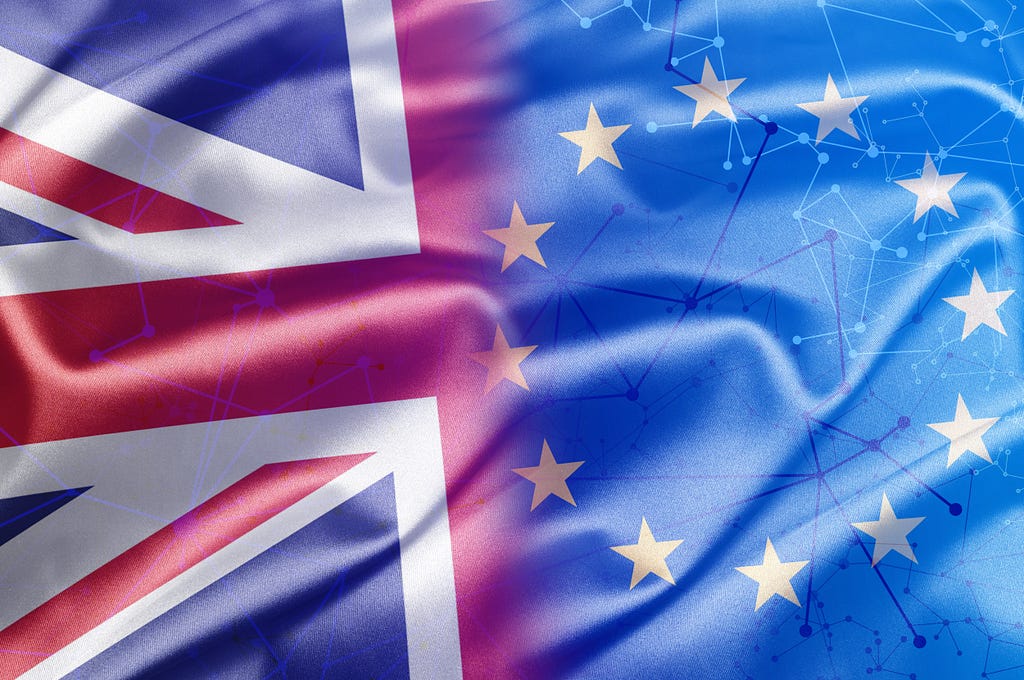
THE GIST: The EU referendum on 23 June 2016 will decide whether the United Kingdom should leave or remain in the European Union. Since the gap between remain and leave has been narrowing in opinion polls, I have analysed the online discussions pertaining to the EU referendum from 28k media posts of 15k Instagram users. My analysis shows that Brexit-supporters are more passionate, more outspoken and more aggressive in online debates. Furthermore, a semantic analysis of 13k relevant hashtags reveals that the leave camp uses hashtags in a much more organised fashion to dominate the networked public and polarise the debate.
As part of the World Economic Forum’s regional programme on Europe, I was invited to participate in the “Britain in the World” meeting in May 2016 to meet with Prime Minister David Cameron and ten members of the UK Government to discuss the implications of a potential Brexit for the UK. As a Global Shaper, my responsibility was to represent the voices of the millennial generation and help explore the role that young people have to play in the future of the UK and the European Union.
While the main focus of the meeting agenda was concerned with the social, economic and political implications on the EU referendum, I decided to use my knowledge and skills as a network scientist to provide a bit of context for the meeting by computationally studying the ongoing online discussions around the EU referendum, using large-scale big data analytic tools from my doctoral research at the Oxford Internet Institute.
Membership in the EU has been a topic of debate in the UK since the country joined the European Economic Community in 1973. Now, how will Britain’s relationship with Europe and the wider world change after the referendum? And what are ordinary Internet users saying about this pivotal moment for British politics, business and society?
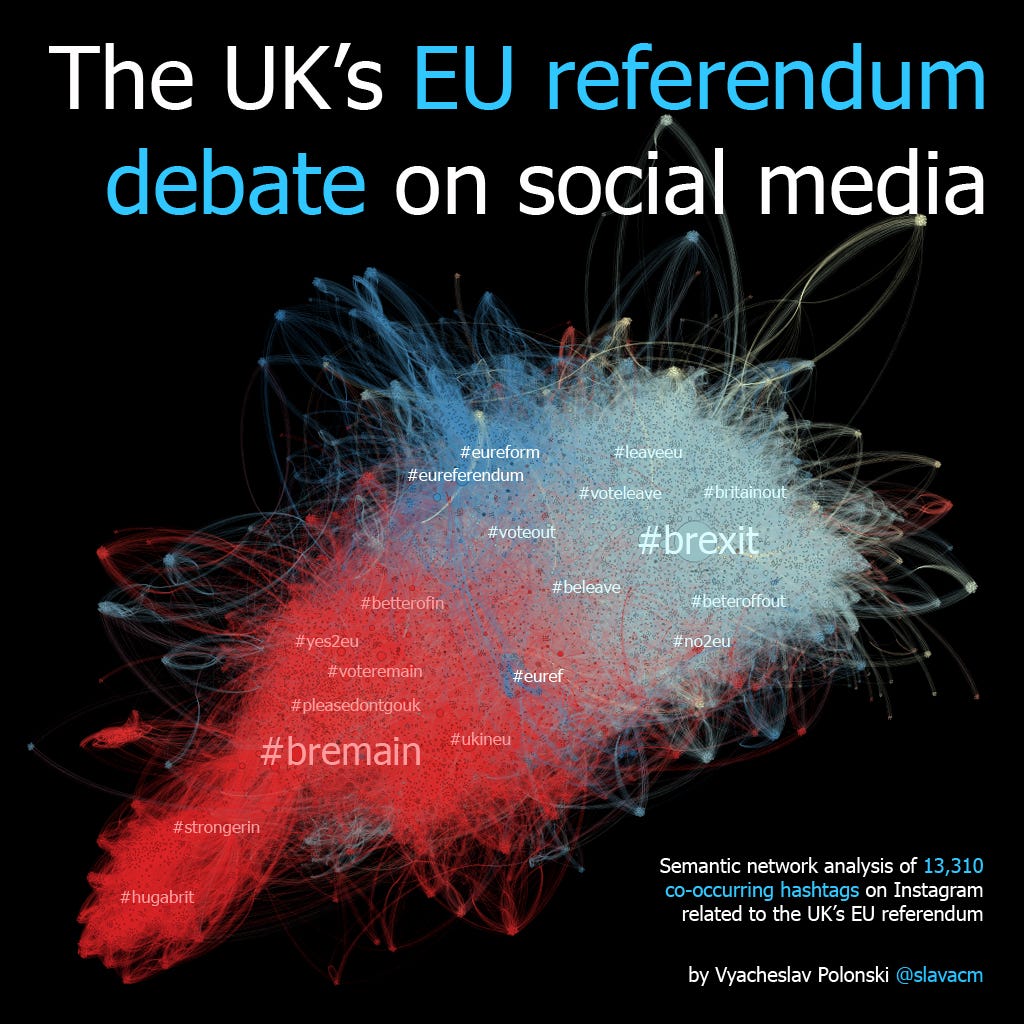
For this analysis, I have looked at 13,310 distinct hashtags on Instagram (as shown in the semantic network visualisation above). This data was extracted from from 15,933 unique users who have posted 28,940 media posts related to the UK’s EU referendum with a total of over 830,690 words and 6,550,613 characters. A map of the geographical distribution of posts is presented at the end of this blog post.
In our analysis, we find that there are twice as many Instagram users calling for an exit from the European Union compared to Instagram users who are asserting that the UK should remain in the EU. This does not mean, however, that there is a greater absolute number of Brexit-supporters in the UK. What this data implies is that Brexit-supporters are more outspoken online and more active in sharing Instagram content — similar to other online social networks. This is indeed alarming, because these online opinions can influence voters who are still undecided on the EU.
The semantic analysis of hashtags reveals an extremely polarised networked public. Even though there is a lot of debate between the two opposing camps, the visualisation above shows that there are two large clusters of hashtags that are rarely used in combination with one another. Consequently, this leads to even more polarisation, because pro-EU posts are mostly addressing the remain camp, while anti-EU posts are mostly addressing the leave camp. Since online social media has generally decreased the costs of producing, distributing and discovering political information, one would expect to see more exposure and interconnections between the two camps. Nevertheless, the data shows that there is a measurable ideological distance between groups of Internet users in the EU referendum debate that can lead to echo chambers that are dysfunctional for a healthy democratic discourse.
It is worth noting, however, that Brexit-related hashtags are much better integrated in the overall debate. Investigating the semantic network of hashtags, it turns out that the most central hashtags in the debate are #beleave (degree: 6,029), #brexit (degree: 2,089) and #voteout (degree: 1,743). Conversely, the most integrated hashtags on the pro-EU side are #bremain (degree: 1,349), #strongerin (degree: 1,182) and #hugabrit (degree: 860). Unsurprisingly, the most commonly used neutral hashtags co-tagged with the hashtags above are #EU (degree: 1,528), #UK (degree: 1,271) and #EUreferendum (degree: 1,249). Degree count in the network above represents a measure of centrality of hashtags in the referendum debate on Instagram. This shows that EU sceptics tend to dominate the online discourse, making a large number of statements in support of the Brexit.
The most active Instagram user in the dataset was Mr Robert Warwick (minder007), who has tagged over 419 Instagram posts with the #brexit hashtag, 233 posts with the #voteleave hashtag and 103 posts with the #leaveEU hashtag. The official Instagram account of the VoteLeave campaign (voteleave) comes second with 259 Instagram posts in the online debate. The third place in this “leader-board” goes to Ian Geldard (igeldard), who has posted at least 145 relevant Instagram posts to raise support for #brexit.
Moreover, 6.52% of users in the dataset had more than 1000 followers and could be considered influencers in this discussion. The most followed Instagram users who have posted at least one relevant photo to this debate were: Dezeen, an architecture & design magazine (dezeen, 893, 886 followers), the official Instagram account of The Economist (theeconomist, 494,446 followers) and the fashion-icon turned business-woman Maria Hatzistefanis (mrsrodial, 424,513 followers). The official accounts of The Guardian (guardian), France24 (france24) and SkyNews (skynews) come next with 326,495, 238,763 and 199,077 Instagram followers respectively. Certainly, a diverse group of users, to say the least.
As explained in one of my previous posts, having a big microphone is not the same as having real influence. In this regard, the data shows that the most well-received Instagram posts and the most debated posts did neither originate from the most active, nor the most followed users. In fact, the most debated Instagram photo with 260 comments comes from the Instagram user post.libertarian (3,293 posts, 7,199 followers), featuring U.S. President Barack Obama and Donald Trump in a somewhat provocative post:
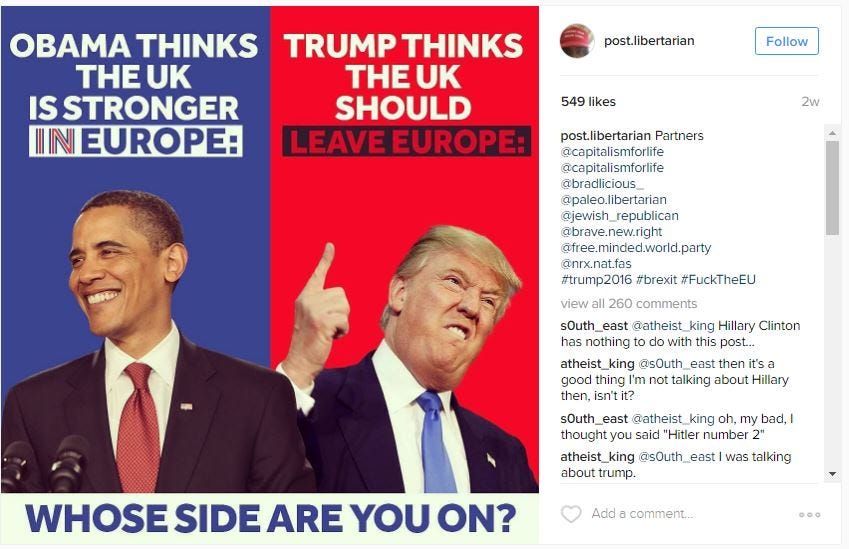
The second most debated photograph with 225 comments came from the #bremain camp and was posted by the user anton_lizard_chaser (128 posts, 10,200 followers). The somewhat bizarre caption that spurred a lot of debate on Instagram reads: “Hola citizens of the U.K. don’t lose your low cost flights and access to Vitamin D #voteyes stay with us in the EU! We love you”.

Finally, the third most debated Instagram post with 106 comments was shared by the official ITV News account (1,289 posts 74,100 followers). Even though the post was meant to be neutral to inform citizens about both the risks and the benefits of a potential Brexit, the comment section was quickly hijacked by Brexit-supporters spamming the section with “Leave!” comments:

Next, let’s look at the Instagram posts that have received a lot of attention and support from the community. For some inexplicable reason, the most well-received Instagram photograph in the dataset that has gained over 4,380 likes was posted by the ordinary Slovakian Instagram user Adriana Riganova (45 posts, 867 followers). Since her post is only distantly related to the EU referendum, I will instead focus on the second most liked Instagram photograph in the dataset with 4,106 likes. Being clearly more relevant to the Brexit debate, it was posted by the Instagram user dezeen (3,010 posts, 611,464 followers) and introduced a series of photographs by the German photographer Wolfgang Tillmans to encourage UK residents to vote to stay in the European Union. This set of photographs was instrumental in activating the remain camp online after the Internet public has been seemingly taken over by radical Euro-sceptics and Brexit-supporters:

The third most popular Instagram photograph in the debate was shared by The Economist (2,645 posts, 494,446 followers) and received 3,451 likes from the community. Featuring an aerial view of the white cliffs of Dover, the caption of the post presents an argument about the single market of the EU:
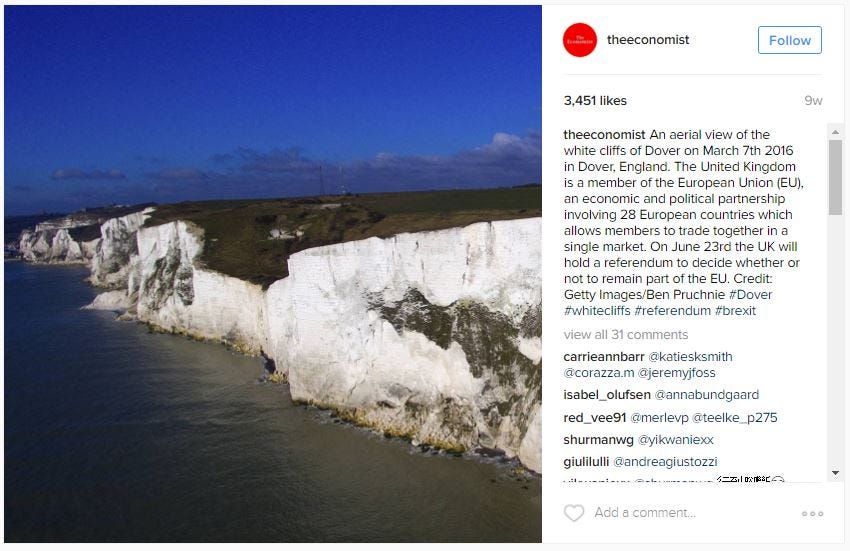
Next up is a classical Instagram user that fits every stereotype people might have about the visual social network: Naomi-Jane Adams (2,067 posts 103,861 followers) is a luxury travel & lifestyle blogger on Instagram who usually posts photographs of yachts, cocktails and paradise-like beaches. This post, however, is surprisingly political and serious, calling all expatriates to support the Bremain-campaign. This post generated over 2,478 likes and was picked up by several EU advocates. Interestingly, Naomi-Jane has also submitted a second post to the EU debate in which she managed to combine her warm feelings for Europe and George Clooney, resulting in a total of over 2,420 likes for the post.
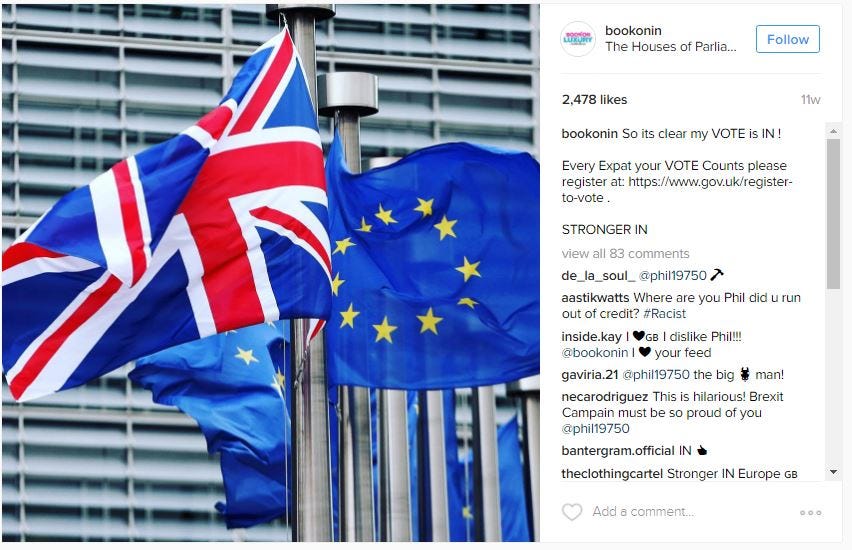
Arguably, the most informative and productive post in the analysed data around the EU referendum debate was, again, shared by The Economist. The post that collected in excess of 2,218 likes features an info-graphic with arguments both in favour and against a potential Brexit:
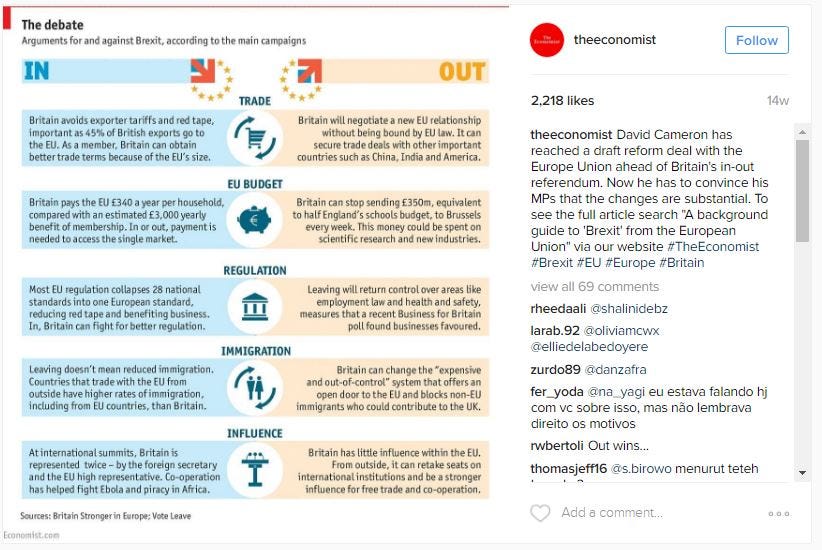
Since we’re talking about Instagram, we cannot leave the discussion without touching on filter choices of the shared posts. Astoundingly, 69.51% of the 28,940 Instagram posts captured for this analysis were “nofilter” posts i.e. they did not use any Instagram filters. The most popular filter in the dataset was Clarendon (1,612 posts), followed by Juno (911 posts), Lark (762 posts), Ludwig (509 posts), Lo-Fi (478 posts) and X-Pro II (471 posts).
An analysis of 4,618 geo-tags in the dataset provides an interesting pattern of activity related to the EU referendum debate. Naturally, the UK is the largest area for geo-tagged content related to the EU referendum debate, with other hotbeds of activity in Germany, Italy, France and Spain, as well as in the USA, Australia, Indonesia and Brazil. This pattern has largely persisted over time, despite the geographic diversification of posted content.

For Britain and EU alike, the possible effects of a Brexit could be enormous— and this is evident in the heated debates between the leave and remain camps that are happening online. My data analysis shows that the EU referendum online debate is not only one that is subject to a great deal of uncertainty, but also one that is characterised by ideological polarisation. Consequently, arguments on both sides of the debate are amplified and reinforced by transmission and repetition inside each camp, leading to oftentimes dysfunctional discussions that can hardly be described as a healthy democratic discourse. Furthermore, the data shows that EU-sceptics and Brexit-supporters currently dominate many of the ongoing online discussions inasmuch as they tend to be more passionate, more outspoken and more aggressive in their online activities.
In a 2013 landmark speech about Britain’s generational question, Prime Minister David Cameron stated: “It is time for the British people to have their say. It is time to settle this European question in British politics.” Now, it is unlikely that this referendum will solve all the complex and multifaceted issues in the relationship between the European Union and the UK once and for all. Rather, it presents us with a choice and a step forward in managing some of these issues. The problem is, however, that none of us really knows what the future repercussions of a potential Brexit could be for the UK, for Europe and the world. In or out — the entirety of the British electorate, each citizen of the UK, needs to make this important decision by making a judgement call about the balance of risks between the costs and benefits of being part of the European Union.
About the author: Vyacheslav (@slavacm) is a doctoral candidate at the Oxford Internet Institute, researching complex social networks, digital identity and technology adoption. He has previously studied at Harvard University, Oxford University and the London School of Economics and Political Science. Vyacheslav is actively involved in the World Economic Forum and its Global Shapers community, where he is the Curator of the Oxford Hub. He writes about the intersection of sociology, network science and technology.
If you enjoyed this post, please hit the tiny “heart” button, leave a comment below or share this post with your friends and colleagues!